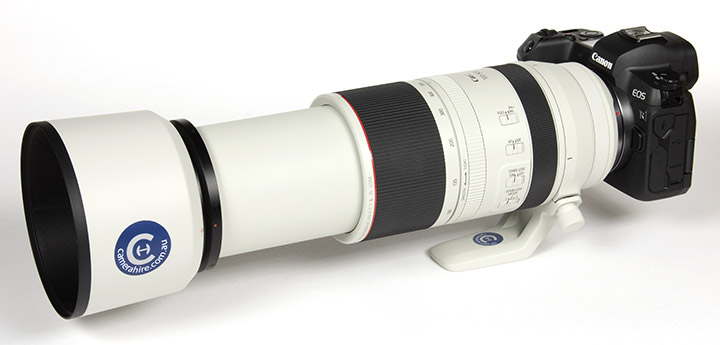|
Canon RF 100-500mm f/4.5-7.1 USM L IS - Review / Test Report |
|
Lens Reviews -
Canon EOS (Full Format)
|
|
Page 1 of 3
Review by Klaus Schroiff, published December 2020

Introduction
Canon has been THE dominant player in the super-telephoto arena for decades. There are many photos of sports events where you can see a myriad of white Canon L lenses in the press section. Besides lots of prime lenses, Canon has always offered moderately fast long tele-zoom lenses, with the most popular one being the EF 100-400mm f/4.5-5.6 USM L IS (II). However, during recent years this lens felt a bit conservative regarding a competition that moved on to 500mm and even 600mm at the long end. And for sports/wildlife photographers, nothing beats a long focal length but a longer one. Obviously, Canon heard the call and they upgraded their offering accordingly - the Canon RF 100-500mm f/4.5-7.1 USM L IS. This is no discount offer at around 2700USD/3100EUR which is, at least in Europe, substantially more expensive than the older DSLR lens.
 Given its L-class designation, the lens is targeting professional users thus it's not surprising that the build quality is superb. The lens body is mostly made of metal and high-quality composite materials. It extends when zooming towards the long end. This may be a bit unfortunate but combined with the rather slow speed, this results in a comparatively compact transport size at least. Fully extended to 500mm and with the attached hood, it is quite a sight though, as you can see below. The focal length can be locked in position using a dedicated adjustment ring. Besides the smoothly operating zoom and focus control rings, there's also the usual customizable control ring near the mount. Typical for all L-class lenses, there's extensive sealing against dust and water - and this is also needed because you are pumping lots of air in and out of the lens during zooming. The supplied tripod mount is detachable.
Given its L-class designation, the lens is targeting professional users thus it's not surprising that the build quality is superb. The lens body is mostly made of metal and high-quality composite materials. It extends when zooming towards the long end. This may be a bit unfortunate but combined with the rather slow speed, this results in a comparatively compact transport size at least. Fully extended to 500mm and with the attached hood, it is quite a sight though, as you can see below. The focal length can be locked in position using a dedicated adjustment ring. Besides the smoothly operating zoom and focus control rings, there's also the usual customizable control ring near the mount. Typical for all L-class lenses, there's extensive sealing against dust and water - and this is also needed because you are pumping lots of air in and out of the lens during zooming. The supplied tripod mount is detachable.
 The Canon RF 100-500mm f/4.5-7.1 USM L IS uses an ultrasonic AF motor for focusing. The AF speed is pretty fast. A 5 f-stop optical image stabilizer is also incorporated. Its efficiency can be boosted via an in-camera image stabilizer by another stop (on the R5 and R6).
The Canon RF 100-500mm f/4.5-7.1 USM L IS uses an ultrasonic AF motor for focusing. The AF speed is pretty fast. A 5 f-stop optical image stabilizer is also incorporated. Its efficiency can be boosted via an in-camera image stabilizer by another stop (on the R5 and R6).
 That being said, we had major issues with this lens on the EOS R. Canon released a firmware update for the EOS R AFTER the completion of the review which may have fixed our problems but during our field sessions, spot AF was unusable in certain scenes at focal lengths >350mm and the image stabilizer was not effective at longer focal lengths (soft images of static scenes at 1/500s at 500mm). For the field shots, we had to use a broader AF field and very high shutter speeds. Thus if you own an EOS R or RP and have the same issues, you should upgrade the firmware to the latest state. While you may cheer the fact that issues can be fixed via firmware, it is somewhat sad to see that this has become a requirement though.
That being said, we had major issues with this lens on the EOS R. Canon released a firmware update for the EOS R AFTER the completion of the review which may have fixed our problems but during our field sessions, spot AF was unusable in certain scenes at focal lengths >350mm and the image stabilizer was not effective at longer focal lengths (soft images of static scenes at 1/500s at 500mm). For the field shots, we had to use a broader AF field and very high shutter speeds. Thus if you own an EOS R or RP and have the same issues, you should upgrade the firmware to the latest state. While you may cheer the fact that issues can be fixed via firmware, it is somewhat sad to see that this has become a requirement though.
| Specifications |
|---|
| Optical construction | 20 elements in 14 groups inc. 1x SUD, 6x UD elements |
| Number of aperture blades | 9 (rounded) |
| min. focus distance | 0.9m (max magnification 1:3) |
| Dimensions | 93.8x207.9mm |
| Weight | 1370g |
| Filter size | 77mm |
| Hood | barrel-shaped, bayonet mount, supplied |
| Other features | dust- and moisture-resistant, 3-mode OSS, tripod mount, focus limiter |
|